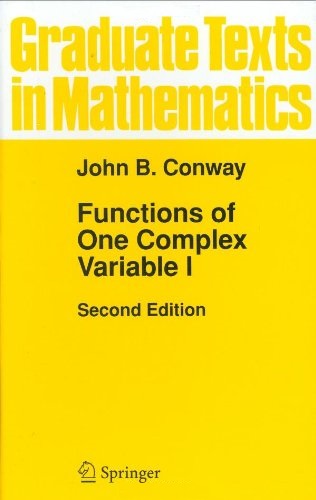
COURSE: MATH 5510
TIME: 9:45--11:05 TR; PLACE: Room 112C of Wilson-Wallace Hall; CALL# 80433
INSTRUCTOR: Dr. Robert Gardner; OFFICE: Room 308F of Gilbreath Hall
OFFICE HOURS: 10:15-11:15 MWF; PHONE: 439-6979 (Math Office 439-4349)
E-MAIL: gardnerr@etsu.edu
WEBPAGE: www.etsu.edu/math/gardner/gardner.htm (see my webpage for a copy of this course syllabus and updates for the course).
TEXT: Functions of One Complex Variable, Second Edition, by John Conway.

PREREQUISITE: An undergraduate real analysis class or advanced calculus class.
ABOUT THE COURSE: It will be assumed that the student has been exposed to (and has a reasonable recollection of) the topology of R (open and closed sets, limit points, connectedness, compactness, completeness, lub and sup, glb and inf, sequences and series of real numbers, convergence, uniform convergence, comparison tests, Cauchy sequences), and properties of functions of a real variable (continuity, differentiability, power series representation). It is also assumed that the student has been exposed to some elementary properties of the complex numbers (algebra, geometry, roots of unity, modulus) and functions of complex variables.
OUTLINE:
Our tentative outline is:
Chapter 1. The Complex Number System: Introduction to the complex plane, real and imaginary parts, modulus, polar representation,
extended complex plane, Riemann sphere.
Chapter 2. Metric Spaces and Topology of C: Extensions of several ideas from R to C and other metric spaces, open and
closed sets, connectedness, sequences, completeness, compact sets, continuity, convergence, uniform convergence.
Chapter 3. Elementary Properties and Examples of Analytic Functions: Series, convergence of series, differentiability, analytic
functions, mappings, Mobius transformations.
Chapter 4. Complex Integration: Riemann-Stieltjes integrals, power series, zeros of analytic functions, Fundamental Theorem of Algebra,
Maximum Modulus Theorem, winding number, Cauchy's Integral Formula, properties of path integrals, Open Mapping Theorem.
GRADING: Homework (H) to be turned in will be assigned regularly. We will have two tests (T1 and T2) and your average will be computed as follows:
IMPORTANT DATES:
Monday, September 5 = Labor Day Holiday.
Friday, September 9 = Last day for 75% refund of fees.
Friday, September 9 = Last day to drop without a grade of "W."
Friday, September 23 = Last day for 25% refund of fees.
Monday and Tuesday, October 17 and 18 = Fall Break Holiday.
Monday, October 24 = Last day to drop without dean's permission.
Tuesday, November 1 = Midterm Exam.
Thursday and Friday, November 24 and 25 = Thanksgiving Holiday.
Wednesday, December 7 = Last day to withdraw from the university.
Friday, December 9 = Last day of class.
Thursday, December 15 = Comprehensive final, 8:00 a.m. to 10:00 a.m.
OTHER RESOURCES. The following were mentioned in class:
HOMEWORK.The following homework is assigned:
Return to
Bob Gardner's webpage
Last Updated: January 2, 2012.